Whether you are into martial arts, have a scary ex-boyfriend, or want to be prepared for a disaster, you’ll want to have weapons as part of your self-defense and survival plan.
Even Jackie Chan and Chuck Norris use weapons in their movies, and I doubt you are as good with your feet and fists as they are.
Many people will automatically assume that a gun is the best survival weapon, but this isn’t always the case.
Each weapon has its pros and cons for specific situations. Take the time to learn the types of weapons so you can be prepared!
Impact Weapons
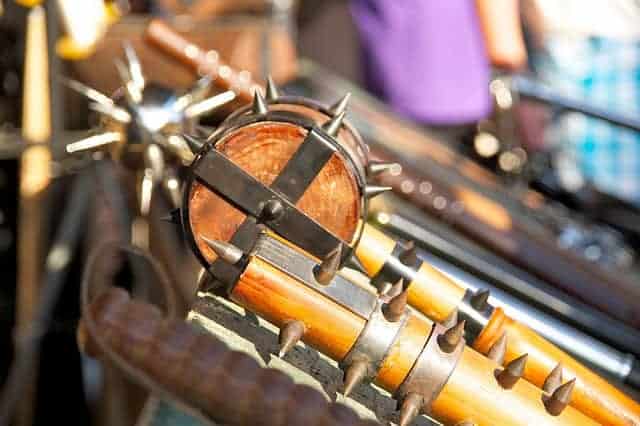
Also called trauma weapons, these are the oldest weapons ever used by humanity.
The original impact weapon was probably just a heavy rock thrown at an attacking animal. Over the centuries, impact weapons have picked up some terrifying modifications, like spiked ends.
Examples of impact weapons include:
- Clubs/bats
- Sledgehammer
- Mace
- Batons
- Flexible impact weapons (whips, chains…)
If you are going into combat against an unarmed attacker, an impact weapon will provide you with a great advantage. For starters, it gives you greater reach so you can hit the attacker before he even gets close to you.
Impact weapons can also knock weapons out of an attacker’s hands. A significant plus of impact weapons is that they are easy to make (like these DIY weapons).
Prisoners have been known to make them out of rolled up towels with bars of soap inside. Simple yet highly effective!
The obvious disadvantage of impact weapons is that you’ve got to be close to your attacker to use them. If the attacker has an even longer-range weapon (like a gun), then it won’t do you much good. You’d have to use it strategically, such as hiding from the attacker and using the weapon to bash his head in.
Throwing/Projectile Weapons
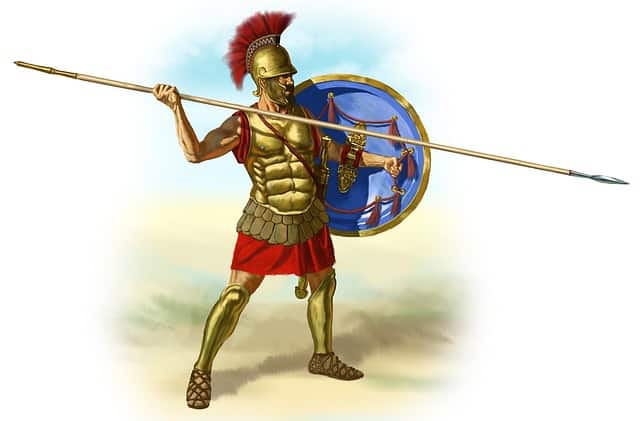
If you are being attacked, you want to keep as much distance between you and the attacker as possible, as this will minimize the risk of you getting struck and injured.
Therein lies the advantage of throwing weapons.
There are many downsides to these weapons, though, like the fact that you have to have good aim and will lose your weapon after throwing it (which could mean it ends up in the attacker’s hands!).
Examples of throwing weapons include:
- Boomerang (Amazon Link)
- Spears
- Javelin
- Arrows
- Shuriken (Amazon Link)
- Throwing axes (Amazon Link)
- Bows (Amazon Link)
- Throwing Knives
Bladed Weapons
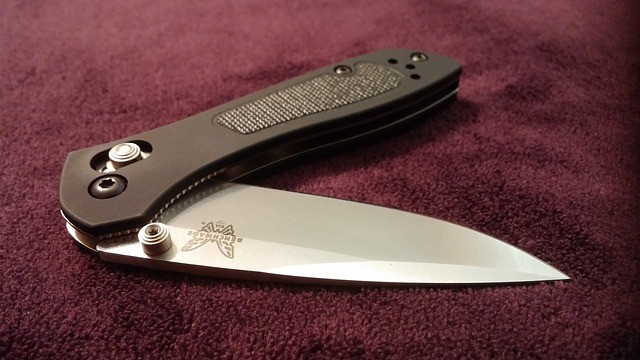
The first bladed weapons go back to the bronze age in 1700 BC. For hundreds of years, these were the weapons of choice.
Bladed weapons are capable of producing debilitating wounds very quickly.
Long bladed weapons, such as swords, also allow you to distance yourself from the attacker.
Another plus of bladed weapons is that they can be used for other purposes, such as chopping up your dinner.
In modern combat and self defense, bladed weapons have a lot of disadvantages. First off, it takes skill and training to use a sword!
Knives and other short blades might be beneficial in a street fight, but you would need to get lucky and hit a vital organ. Otherwise, you aren’t going to debilitate the opponent and can get injured.
I would rather have a spiked club than a knife as a weapon!
Examples of bladed weapons include:
- Knives – Best survival knife options
- Daggers (Amazon Link)
- Swords
- Shivs
- Axes (read about different types of axes)
Firearm Weapons
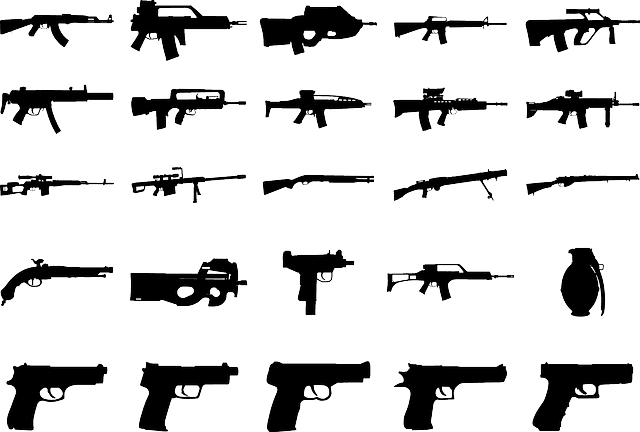
When firearms were first used in combat in about the 14th century, it changed history. It now became possible to attack enemies at such a distance that they had no alternative but to flee.
Today’s firearms have become so sophisticated that they have features like electronic target tracking and virtually unlimited rounds.
There are some disadvantages to using firearms as a survival weapon. Aside from the obvious bureaucratic issues like permits and legality, there is the fact that firearms rely on ammo (which is why ammo will make a valuable survival barter item).
A pistol is useless once you run out of bullets unless you want to throw it at your attacker.
The loud bang of the firearm could also alert others to your location, bringing on even more attackers.
Explosive Weapons
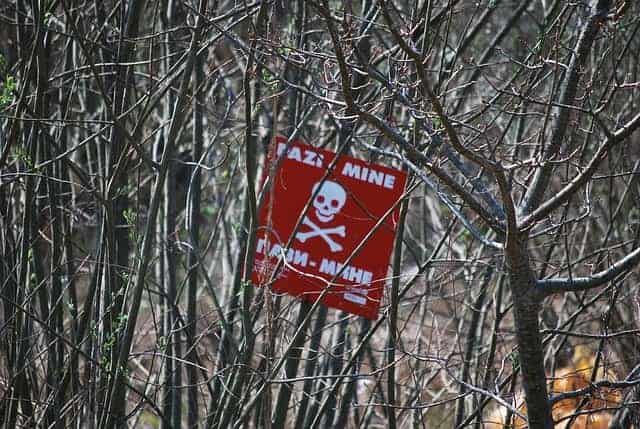
It only takes a basic knowledge of chemistry to make a bomb, and already, we’ve seen numerous examples of homemade explosives wreaking havoc.
The most famous is probably Timothy McVeigh, who killed 168 people and injured over 600 with a truck bomb during the Oklahoma City bombing. And there was Ted Kaczynski, who mailed bombs to universities and airlines. In modern warfare, improvised explosive devices (IEDs) are a considerable threat. IEDs accounted for 63% of coalition deaths in the recent Iraq war.
The core benefit of using explosive devices is that you can injure your enemy without even being there, such as with landmines or bombs set on timers. However, explosive weapons can be highly unreliable.
Many people attempting to make homemade bombs end up killing themselves when they accidentally go off.
Some examples of explosive weapons include:
- Landmines
- Bombs
- Grenades
- Improvised explosive devices
Flamethrower Weapons

For me, these are the downright scariest types of weapons. I’d rather be blown up by a bomb than have my skin burned off with a flamethrower!
The Greeks likely used the first flamethrower on their naval ships. They would use handheld flame devices to burn enemy ships.
It wasn’t until WWI that the modern flamethrower came into combat, though. The Germans used flamethrowers in more than 600 battles.
Flamethrowers have a lot of disadvantages, like being very heavy to carry and usually requiring teams to operate.
They can also malfunction and cause injury to the operators.
Flamethrowers have come a long way, though. Modern flamethrowers can light targets 160 to 260 away. Soldiers can spray flammable liquid over targets first and then use the flamethrower to set them on fire.
Artillery Weapons
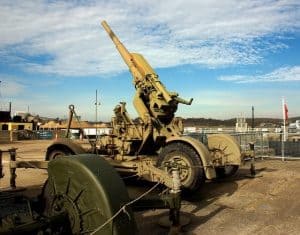
Artillery is a big category of weapons, which includes any mounted projectile weapon that isn’t a small arm.
Artillery technology is constantly being improved upon to the point that civilians are defenseless against these weapons.
For survival, you could make your own primitive artillery, like a catapult or improvised cannon, but you’re probably better off fleeing if you need artillery!
Examples of artillery include:
- Catapults
- Cannons
- Mortars
- Rockets
- Missiles
Which one weapon would you want when SHTF?
Redneck zombie killing team by Mathew Hogan; Found on Flickr; CC SA 2.0
No title by John Crider; found on Flickr; CC BY NC ND 2.0



No matter the choice there are limits. I have a few choices from your list. First a quality knife has a lot of use besides combat. Skin your game, slice it into strips for drying, cutting cord, gutting fish etc. to name a few. Second choice is a crossbow because I know I cannot throw a spear well enough for hunting or protection bolts can be handmade and fletched. Third a decent rifle for ultimate range, and a hand gun for close up defense. When the bullets are gone they will be useless if you are pressed into shooting at someone but you might scavenged bullets for awhile if you are careful to search for them. Choosing just one is not sound if you ask my humble opinion.
Honestly, one of my favorite articles. I love the classification and research, thank you for creating such an interesting article.
Thanks. We are glad you found it useful. 🙂
Very educational-Thank you
Your posts are very interesting and a great thing to help decide the things we may need. Thank you